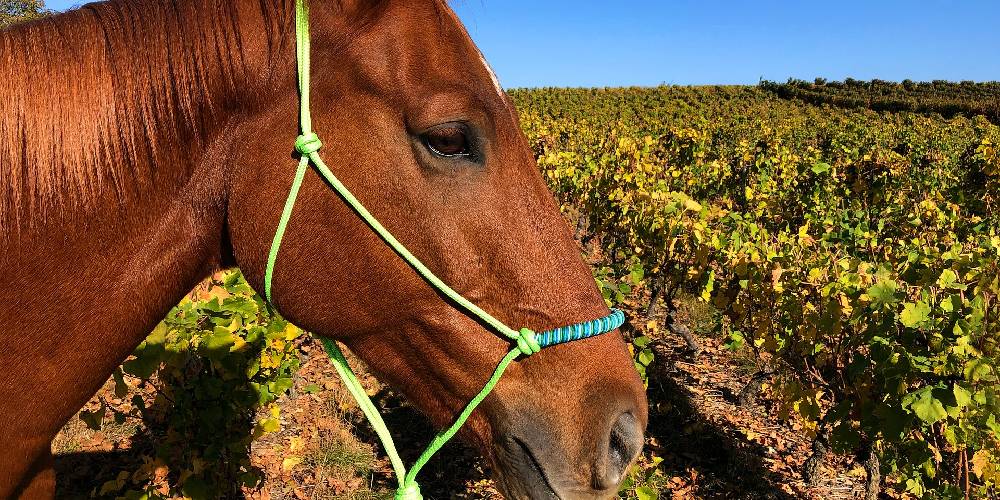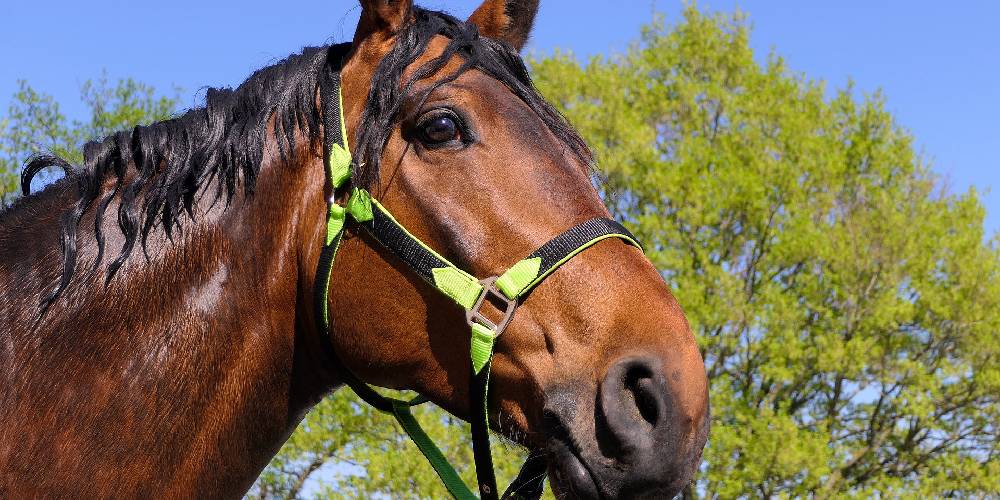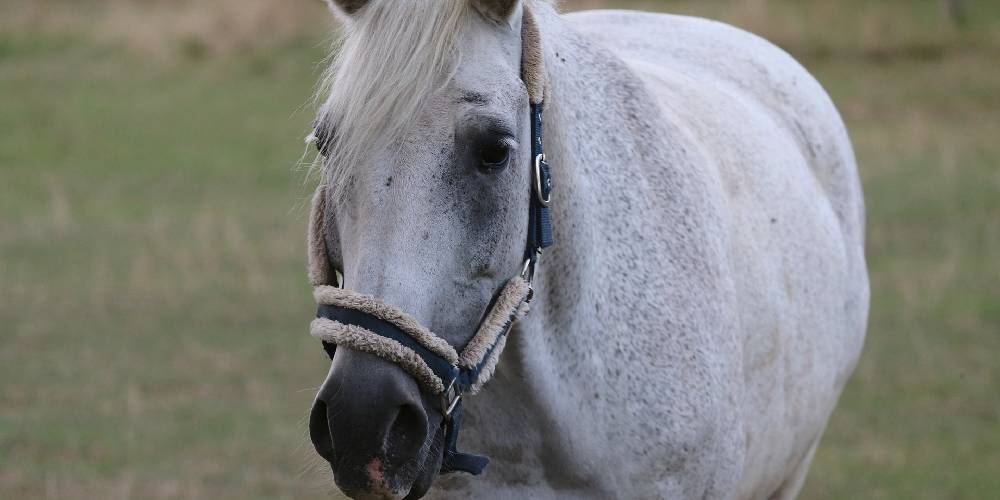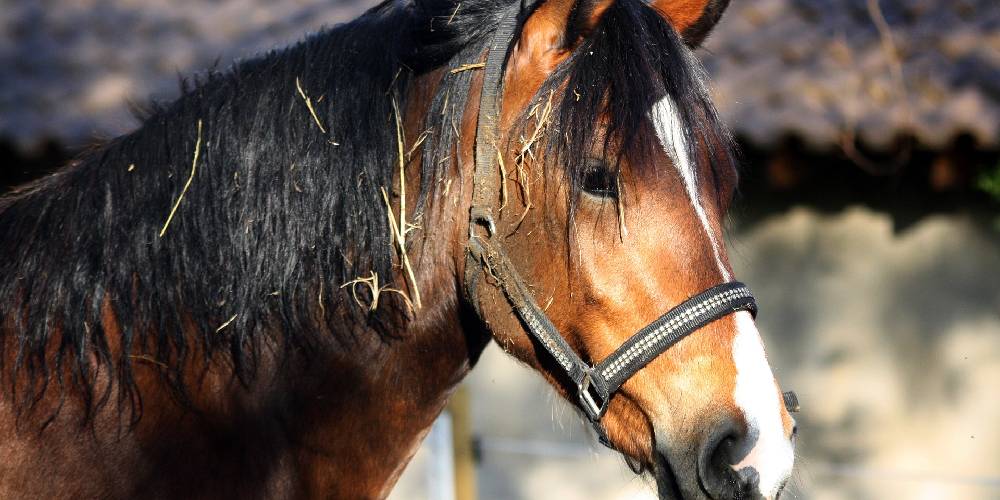A halter is a piece of tack used by nearly all horse owners, riders, and handlers at all levels. The halter is used for leading a horse, tying a horse, or catching a horse. This piece of equipment can be found in all shapes, sizes, colors, materials, and styles.
What Is A Halter?
A halter is a piece of tack that fastens onto the horse’s head to make leading and handling horses easier. Halters can be made of a variety of materials including nylon, paracord, leather, faux leather, or a combination of these materials. To put a halter on, put the noseband over and around the horse’s muzzle, and pull it up before putting the crown piece behind the ears and buckling it on the left side of the horse’s head.
What Are Halters Used For?
Halters are used for a variety of things including:
- Leading a horse
- Tying a horse up
- Holding a horse on cross ties
- Holding a horse standing
- Lunging a horse
- Catching a horse
Parts Of The Halter

Knowing the parts of the halter can be important to know to ensure you put the halter on properly. The parts of the halter include the:
Noseband
The Noseband is a part of the halter that is easy to identify as it is, well, the band that goes around the horse’s nose. The nose band truly has two parts. These are The nose piece and the chin piece. The nose piece is basically the strap of the halter that lies just above the horse’s muzzle over their nose. The chin piece of the halter falls underneath the bottom of the horse’s head just below their chin. The nose band should never be snug on a horse’s head. It should always be loose.
Tie Ring
The tie ring is a ring that is attached to the chin piece on the nose band and it falls just below the horse’s chin. It is called the tie ring as this is where the lead rope is fastened when a horse is being led.
Connecting Strap
The connecting strap is a strap that lies underneath the horse’s head that stretches from the tie ring to the throat latch. This strap helps to keep the halter from getting turned inside out, helps to keep the halter on the horse, and helps to better show which is the top and bottom of the halter.
Cheekpiece
There are two cheek pieces on the halter, one on the left and one on the right side of the horse’s head. The cheekpieces help to keep the halter on the horse and connect the noseband to the throat latch and crown piece.
Throat Latch
The throat latch is a strap that travels underneath the horse’s throat and is attached to the connecting strap that falls just below the horse’s head. On some halters, there is a snap that can be undone for easy halter removal. This snap is connected to the throat latch and it snaps onto a ring just below the buckle on the halter.
Snap
Some halters have a snap that is attached to the throat latch. This snap allows the throat latch to be undone to allow for easier halter removal. The snap attaches to a ring just below the buckle on the halter.
Buckle
The buckle on the halter is one of the main ways that a halter is put on and taken off. This buckle is fastened to the crown piece and is the way that the horse’s halter stays on its face. Some styles of halters don’t come with a buckle and instead have a loop that the crown piece passes through.
Crown Piece
The crown piece is a strap that goes behind the horse’s ears and is attached to the buckle. Without the crown piece, the halter is unable to stay on. On some halters, there are several holes punched into the crown piece so the tightness and length of the halter can be adjusted.
Are Halters Hard To Find & Where Can I Find Them?
Actually, halters are one of the easiest pieces of horse tack/equipment to find out of all the types of tack out there. Halters are sold at nearly any feed and tack store and some pet stores as well. Some hardware stores will even carry halters if the community where they are based is known to have horses.
What Materials Are Halters Made Of?

Halters can be made of many different materials. The mane materials that they are made of include:
Nylon
Nylon is one of the most popular materials used to make halters. This is because it is durable, colorful, cheap, and easy to work with. Nylon halters are also one of the most affordable halters on the market as the material they are made of is cheaper and more popular.
Paracord Or Rope
Another popular material for halters to be made of is from paracord or rope. Usually these halters are called rope halters and differ from all other halters in the sense that they are more flexible, don’t have metal rings or attachments, and stay on the horse from a tied knot rather than a buckle.
Faux Leather
At the barn I ride at, many of the horse’s there use faux leather halters. The reason for this is that typically faux leather halters are cheaper to purchase, but still look like leather making them a little more flashy in appearance as compared to the typical nylon halter.
Leather
Leather halters are most popular in the horse world in higher-level competition barns, show barns, and breeding barns. Often, leather halters will also feature a nameplate showing the horse’s registered name or barn name. Leather halters are of the more expensive halters to purchase.
A Combination Of the Above Materials
Many halters will be made of a mix of materials. One of the common combinations is a nylon halter with a leather crown piece. This halter is intended to break off if the horse is left wearing it when they are out in the turnout or pasture in case they get something snagged on it and they need to break away from it.
Another popular combination is leather and rope. These halters will often have the structure of a rope halter, but a feature a large leather nose piece. These halters are more commonly seen in western barns and worn by western horses.
What Are The Different Sizes That Halters Come In?

Did you know that you can purchase halters for nearly any size horse? The different sizes of halters seen include:
Foal
Yes, there is in fact tiny little halters for foals! These foal halters can be made of nylon, leather, rope, or faux leather and are intended to get a foal used to wearing a halter from a very young age to make handling them and halter breaking them easier.
Weanling
A weanling is a foal that is around six months old or around the age where they are weaned from their mothers. The halters that are made in this size can come in leather, nylon, rope, or faux leather.
Yearling
A yearling is a colt or filly that is one year old. The halter intended for a yearling is much bigger than that for a foal or a weanling. Yearlings, by this point in their lives should be partially, if not fully, halter broke. The halters used for yearlings will, like most other halters, be made from nylon, leather, faux leather, or rope.
I used a yearling-sized halter on my uncle’s rescue burro. It was a perfect fit!
Pony
Pony halters are larger than yearling halters, but smaller than ‘small horse’ halters. These halters also are typically shorter in length because of the shorter length of the typical pony’s head.
Small
Some larger pony breeds fit into the ‘small horse’ halter size. These halters can fit larger ponies like the Welsh Pony, Dales Pony, and the Fell Pony. Small horse halters are, well, small compared to the average horse halter.
Arabian Or Cob
Arabian horses are known for their narrow delicate faces that are usually shorter and more slender in shape and size than that of the average horse. This is why many companies that make halters make a size that is specifically for the Arabian as their face proportions are so unique.
The cob size for horse tack is also similar to the Arabian sizes as they are generally smaller than the ‘horse’ sized options. If you are trying to find a halter for an Arabian and an Arabian halter is not available, usually the cob size is the next closest thing.
Horse
After the Arabian or Cob, comes the horse-sized halter. The horse-sized halter is also sometimes labeled as ‘average horse’ on the halter for the size. This halter is usually able to fit most average-sized hotblooded and warmblooded breeds easily.
Full Or Large
The Full-sized halter is intended for horses that are too large for the average-sized halter. This would include large warmbloods and small draft breeds. Usually, horses that fit a full-sized bridle will fit a full-sized or large-sized halter.
Draft Or X-Large
The next size up is the halter intended for coldblooded draft horses. These halters are gigantic and are made to it nearly every draft breed. Some halters can be made even larger than this if it is needed.
What Is The Average Cost Of A Halter?

The average cost of a halter really depends on the material it is made of, the size of the halter, and the brand from which you buy it. For average-sized halters in each material, the average prices are:
- $20 (USD) for Nylon
- $15 (USD) for Rope
- $70 (USD) for Leather
- $45 (USD) for Faux Leather
What Colors Do Halters Come In?
Halters can literally come in every color under the sun. Rope and nylon halters can come in any color from red to green to black to white and everything in between. Usually, when halters are for sale, there will be a variety of colors to choose from.
Leather and faux leather halters can usually come in tan, dark brown, and black.
Can I Use A Halter Instead Of A Bridle?
Yes and no. Halters are not intended to be used for riding with, but if your horse is responsive enough without a bit in its mouth, a halter can work just fine for a quick ride. If you are not wanting to use a bit, there are bitless bridles that you can buy that might be a better option than a halter, but halters work just fine for temporary use.
Different Kinds Of Halters

There are a lot of different types of halters on the market used for a variety of different things. Some of these halters include:
Show Halter
In halter classes, there are typically two different types of show halters used. There is Arabian halter and Quarter Horse halter. In Arabian halter classes, the horse wears a minimal halter that is held in place by a chain under the chin in lace of a chin piece.
Quarter Horse show halters are basically the same as a normal halter except for the lodas of silver bedazzlement on the noseband and cheekpieces.
Shipping Halter
A shipping halter is basically a halter that is covered in fleece for padding. This is to not only to help protect the horse’s head, but it also helps to prevent the halter from rubbing sore or bald spots into the horse’s face.
Grooming Halters
There are a couple of different styles of grooming halters available on the market. One style is kind of like a collar that goes around the neck to keep the face free for cleaning and grooming. The other type of grooming halter is similar to that of a cavesson or noseband piece you might see on a bridle. It consists of just the crown piece, cheekpieces, and noseband. No connecting piece or throat latch is seen on this type of halter.
Adjustable Halters
Adjustable halters are one of the more commonly seen halters outside of the standard fixed halters. Adjustable halters will often have a buckle on the noseband to allow the noseband to be loosened or tightened as needed. These halters make great choices for young growing horses so you can adjust their halter as they grow and not have to worry about constantly needing to replace them. This is also a good idea for halters that are used on multiple horses.
Breakaway Halters
Breakaway halters are usually made of leather or partly of leather so a horse can break away and snap the halter if they need to. This is a safety device and these halters are mainly worn by horses who wear their halters even when they are in their stall or turned out. The idea is that the leather will break if the horse pulls hard enough thus freeing the horse from whatever it is that is trapping them.

